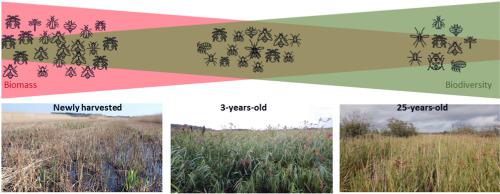Journal of Environmental Management ( IF 8.7 ) Pub Date : 2021-09-11 , DOI: 10.1016/j.jenvman.2021.113637 Line Holm Andersen 1 , Petri Nummi 2 , Jeppe Rafn 1 , Cecilie Majgaard Skak Frederiksen 1 , Mads Prengel Kristjansen 1 , Torben Linding Lauridsen 3 , Kristian Trøjelsgaard 1 , Cino Pertoldi 4 , Dan Bruhn 1 , Simon Bahrndorff 1

|
The succession-driven reed bed habitat hosts a unique flora and fauna including several endangered invertebrate species. Reed beds can be managed through commercial winter harvest, with implications for reed bed conservation. However, the effects of winter harvest on the invertebrate community are not well understood and vary across studies and taxonomic levels. The aim of this study was to investigate the effects of reed harvest on invertebrate communities. Ground-dwelling and aerial invertebrates were continuously sampled for 10 weeks in the largest coherent reed bed of Scandinavia in order to assess how time since last reed harvest (0, 3, and 25-years) influences invertebrate biomass, biodiversity and community structure across taxonomic levels. Biomass was measured and all specimens were sorted to order level, and Coleoptera was even sorted to species level. The invertebrate community showed distinct compositional differences across the three reed bed ages. Furthermore, biomass of both aerial and ground-dwelling invertebrates was highest in the age-0 reed bed and lowest in the age-25 reed bed. Generally, biodiversity showed an opposite trend with the highest richness and diversity in the age-25 reed bed. We conclude that it is possible to ensure high insect biomass and diversity by creating a mosaic of reed bed of different ages through small-scale harvest in the largest coherent reed bed in Scandinavia. The youngest red beds support a high invertebrate biomass whereas the oldest reed beds support a high biodiversity. Collectively, this elevate our understanding of reed harvest and the effects it has on the invertebrate communities, and might aid in future reed bed management and restoration.
中文翻译:

可以将芦苇收获用作改善无脊椎动物生物量和多样性的管理策略吗?
连续驱动的芦苇床栖息地拥有独特的动植物群,包括几种濒临灭绝的无脊椎动物物种。芦苇床可以通过商业冬季收获进行管理,这对芦苇床保护有影响。然而,冬季收获对无脊椎动物群落的影响尚不清楚,并且因研究和分类学水平而异。本研究的目的是调查芦苇收获对无脊椎动物群落的影响。在斯堪的纳维亚最大的连贯芦苇床中连续对地栖和空中无脊椎动物采样 10 周,以评估自上次芦苇收获以来的时间(0、3 和 25 年)如何影响整个分类学的无脊椎动物生物量、生物多样性和群落结构水平。测量了生物量,所有样本都按顺序排序,鞘翅目甚至被分类到物种级别。无脊椎动物群落在三个芦苇床年龄中表现出明显的组成差异。此外,空中和地栖无脊椎动物的生物量在 0 龄芦苇床中最高,在 25 龄芦苇床中最低。总体而言,生物多样性呈相反趋势,25 龄芦苇床的丰富度和多样性最高。我们得出的结论是,通过在斯堪的纳维亚半岛最大的连贯芦苇床中进行小规模收获,可以通过创建不同年龄的芦苇床马赛克来确保高昆虫生物量和多样性。最年轻的红床支持高无脊椎动物生物量,而最古老的芦苇床支持高生物多样性。总的来说,这提升了我们对芦苇收获及其对无脊椎动物群落影响的理解,



























 京公网安备 11010802027423号
京公网安备 11010802027423号